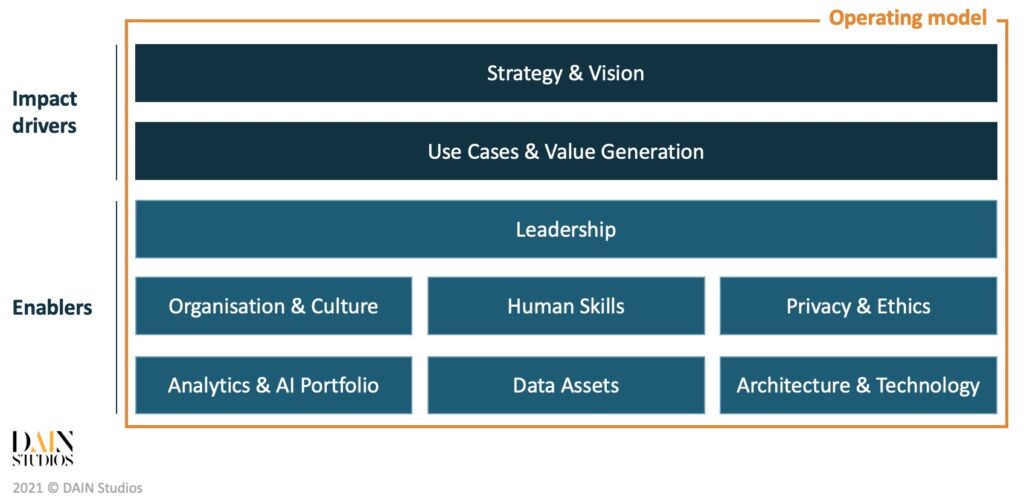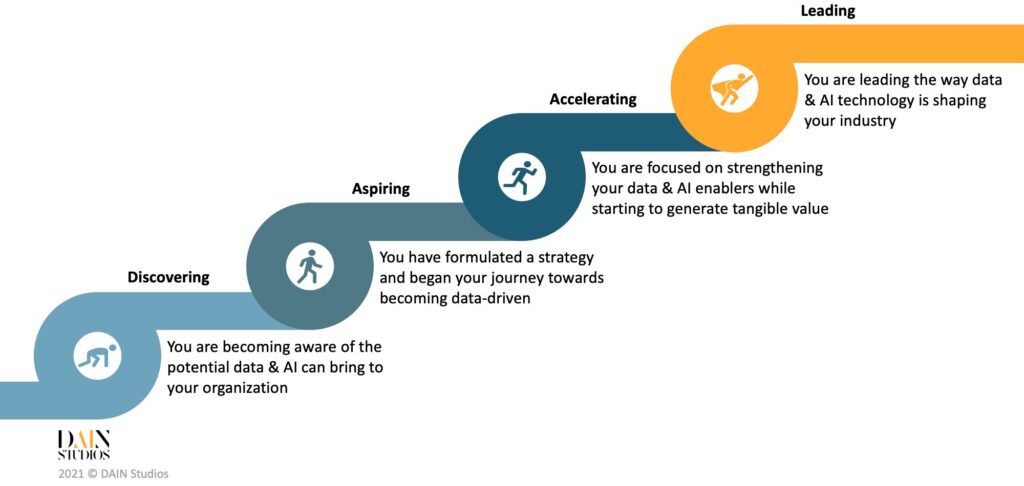Starting to use Data and AI in an organisation is hard. We have seen many organisations fail in their data transformation and have become aware of the common pitfalls. To get your organisation on the right track, you first need to understand where you are. To help you with assessing your current state we are publishing a Data & AI Maturity Model. It gives you a fast assessment of the state of data maturity in your company.
This is Part 1 of our four-part article series explaining how we approach and advise our clients on their data & AI transformation journeys , introducing the DAIN Data & AI Maturity Model.
- Part 1 (this article) gives an overview of the DAIN Data & AI Maturity Model (DAMM).
- Part 2 dives deeper into the strategic impact drivers.
- Part 3 details the organisational and human enablers.
- Part 4 gets to the core technologies of data & AI transformations.
Who cares about maturity, why not just build AI?
A couple of weeks ago we entered a discussion with a recruitment candidate. The candidate asked us: why don’t you focus exclusively on building “real” Artificial Intelligence solutions for your customers? This direct question made us ponder: why indeed would a data & AI consultancy not aim at rolling out the most current, state-of-the-art machine learning solutions?
We of course knew the answer, but the question highlighted the misconceptions and hype present in this field. The primary aim of our projects is to provide solutions that are perceived to be truly valuable for our customer considering their current comprehensive data & AI maturity. Most commonly the customer value is not the shiniest of algorithms, or no algorithm at all!
How to bring bread to the table?
Businesses often approach us with a request for using data & AI within an organisation to solve specific business problems. Other companies may request you use data & AI as a way to keep up with the competitors, who are already using this new technology for their own benefits. While these are attractive offers for a consultancy, they do raise a few red blinking lights.
Contrary to a common belief, using AI is not as simple as adding butter on a piece of bread. If the bread has gone stale or the dough is underdeveloped, the butter will not save it. Similarly, if the data foundation of the company is not mature, the AI solution may look attractive, but it will not deliver the desired value. The whole initiative will leave just a bitter taste.
How to extract value from data?
Today’s business leaders have become acutely aware that staying competitive in the ever-increasing pace of the market means investing in data, analytics, AI, and related capabilities. Yet, the efforts to drive data transformation tend to miss a few critical elements. It may sound attractive to start from shortlisting AI use cases. However, as our Data and AI maturity model shows, using data efficiently demands more than shortlist.
So far, the investments made in many companies have focused on the adoption of the latest digital technology, such as data storage, processing power and analytics. While sophisticated tools can be critical to aforementioned purposes, technology alone isn’t enough to extract true business value. Successfully harnessing the potential of data with technology requires new organisational capabilities. Thus, a shift in the management mindsets is needed. Enterprises need to have more focus on elements of data and digital transformation which have largely been neglected.
Why is DAIN focusing on data and AI maturity?
At DAIN Studios we have executed dozens of projects that have helped our customers in their data transformation strategies and implementations. Planning for improvements demands thorough understanding of the baseline. Commonly the data transformation projects start from assessing the current data & AI maturity of the organisation.
Data & AI maturity is not a single measurable skill. It is rather a number of organisational and technological interlinked capabilities. Due to this complexity understanding the state of Data & AI maturity requires a structured framework and a comprehensive assessment. Only from this assessment one can define clearly articulated steps on what is needed in this business transformation.
The content of the data & AI maturity assessment naturally varies from organisation to organisation. However, based on our collective experience from various industries and regions across Europe, we have identified commonalities in how the most essential data capabilities can bring every enterprise forward.
We will publish these findings in the format of the DAIN Data and AI Maturity Model (DAMM) during spring 2021. The goal is to help organisations with these valuable insights to evaluate and improve their use of data and artificial intelligence.
Introducing the DAIN Data & AI Maturity Model
The DAIN Data & AI Maturity Model divides the data capabilities into Impact drivers and Enablers. The Impact drivers assess how far the use of data is contained in the organisation’s vision and business strategy. With Use Cases & Value Generation we measure how well data use cases and business goals work together. For example is data & analytics a separate function or an integral part of developing the business.

The second section of the model, the Enablers, measure seven different data related capabilities that each have a role in supporting data usage.
The organisational capabilities are Leadership, Organization & Culture, and Human skills. These capabilities assess how skilled the organisation is in developing and understanding data from management to operational levels.
The technological capabilities measure the maturity of the Architecture & Technology. The Architecture evaluates how much automation and manual work is needed to produce value from the data. The Technology stack looks into the actual tools that are used for implementing the architecture and data processing automation.
In addition, the technological capabilities contain the Data Assets and Analytics & AI Portfolio. The Data Asset views the state of the data itself, how broadly and easily the data asset can be used, and what is the quality of the data. Analytics & AI portfolio assess the availability and use of artificial intelligence and advanced analytics.
The final piece of the model is the Privacy & Ethics capability. The purpose of this element is to evaluate how data privacy and ethical use of data is evaluated and implemented.
Four steps to competitive advantage
The benefit of the model is the ability to measure the level of the organisation on the maturity scale. When you know the requirements for each element, it is also easier to see the priorities for improvement. We measure maturity in four levels:
- Discovering – You are becoming aware of the potential of Data and Artificial Intelligence
- Aspiring – You have formulated a strategy and began your journey towards higher data maturity
- Accelerating – You are strengthening your Data and AI maturity while starting to create tangible value
- Leading – You are leading the way Data and AI is shaping your industry
These two dimensions, i.e. the 9 elements of data strategy and the 4 levels of data maturity give rise to the DAIN Data & AI Maturity Model.

How to excel in Data and AI maturity?
Based on a recent survey 99% of Fortune 1000 companies are investing into data and AI capabilities. However, the result of these investments is not that pretty. Only 29.2% say they have achieved transformational business outcomes and only 24% say their companies are data-driven . With all the investments in digital transformation in the past years, why are we seeing so little improvement with data & AI maturity?
The simple answer is that using data and AI is hard. You cannot acquire the capability from a single project or acquire a business transformation license, but rather develop the capabilities over a longer time. Additionally, the data capabilities are only as good as the weakest link. For example, if the management lacks data literacy skills or data assets are not available, using world-class algorithms will not deliver the desired impact.
The purpose of the data & AI maturity model is to assess which are your biggest weaknesses. Knowing them help you to understand which areas need more investments. By improving the weakest links the overall maturity is lifted, and the business outcomes start to appear.